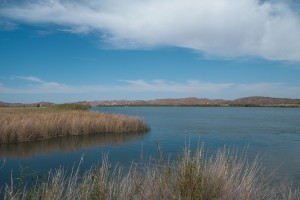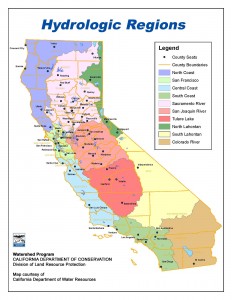I was talking the other day about California’s struggle to solve its Sacramento-San Joaquin Delta problems with a friend who grows food with Colorado River water in California’s southeastern desert. The delta’s more than five hundred miles and three or four watersheds away as the crow flies from his farm. Why such a keen interest?
Here’s the map. My friend’s farm is near the Colorado River in the appropriately colored brown blob down in the bottom right corner. The Sacramento Delta is in the green bit in the center left, near the coast.
The problem lies in the political geography of California water. The Los Angeles-San Diego metro area (the lower green coastal blob on the map) gets large supplies of imported water from both places – the Sacramento Delta and the Colorado River. To the extent that supplies from one of those two places become smaller or less reliable, it places enormous pressure on Southern California to trade that problem off against increased supply and/or reliability from the other. (Both variables, supply size and reliability, are crucial.)
The Sacramento Delta is a mess, both in the plain English sense of the word (“a state of affairs that is confused or full of difficulties”) and in the more subtle framework of Berkeley policy scholar Emery Roe in which policy messes are things not to be cleaned up so much as managed. The Sacramento Delta mess involves a plumbing system that needs to pump vast quantities of water through an ad hoc network of old sloughs and channels ill-suited to the task, completely rejiggering the natural and human environment in a way that creates all sorts of reliability problems along conflicting dimensions – distant human water needs, local human water needs, environmental water needs, local and distant cultural values and needs. Building the big plumbing systems of the 20th century has created interconnections across social and governance boundaries that our 21st century institutions remain poorly equipped to handle.
AroundDeltaWaterGo
One proposed solution is to build ginormous tunnels beneath the damn thing, bypassing the water. California keeps changing the name of this project – it was once a Peripheral Canal rather than a tunnel system, it was the Bay-Delta Conservation Plan, I tried to name it Peripheral Thingie but failed, it’s now California WaterFix, my favorite new name is OtPR’s AroundDeltaWaterGo. More importantly, California keeps not quite deciding to build it, but also not deciding to not build it.

Water behind Imperial Dam is currently headed for desert farms. But will L.A. need it? photo by John Fleck
I am agnostic about whether AroundDeltaWaterGo is a good idea or not. I haven’t spent the time to form an informed opinion (do jump into the comments and explain what an idiot I am for not seeing the obvious merits of your argument for/against). But sitting out here in the Colorado River Basin I am acutely aware of the regional implications of how California handles this mess.
Jeff Kightlinger, head of the Metropolitan Water District of Southern California, has been on a public tear lately arguing the merits of the tunnel scheme:
California WaterFix proposes to build three new intakes in the northern Delta that are outside of the typical migrating range of adult delta smelt. The intakes since January could have been capturing as much as 9,000 cubic feet per second of supplies in addition to what we have been diverting from the existing south Delta facilities.
How much water are we talking about? Every day we cannot capture 9,000 cfs in supplies because we don’t have California WaterFix on line, the lost supply is roughly six times the daily demands of the cities of Los Angeles, San Diego and San Francisco combined.
To the extent that Met can’t grab that water from Northern California, it increases the pressure to look elsewhere. And my farmer friend and his neighbors in the agricultural communities of the deserts of southeastern California – the Imperial Irrigation District, Bard, the Palo Verde Irrigation District – are that “elsewhere”. The ag districts have Colorado River water rights, and Met has an aqueduct that could bring some of that water to the vast metro areas of the coast.
Met right now looks like it has to play a zero sum game. I can see why a farmer in California’s eastern deserts might have some enthusiasm for construction of giant tunnels 500 miles away that will bring him zero water.


Most of our modeling results for California in the future (2050 or so), under an incredible range of climate, economic, and Delta conditions, have the Colorado River Aqueduct full, every month of every year, wet or dry, with about 1.3 maf/year of conveyance from the Colorado basin to southern California. So my impression is that this infrastructure constraint will likely limit the California Delta’s influence on the Colorado River system, unless the Colorado River Aqueduct is expanded. I am a little surprised that southern California has not expressed much interest in expanding the Colorado River Aqueduct, given that water in the lower Colorado basin has lower-valued uses and might be less contentious and cantankerous to tap than the Delta. But people often fight more with neighbors than distant relatives.
Jay –
In practice, right now, Met has been forced by shortages in SWP water to try to keep the aqueduct full, and it has been a struggle. They’re trading off availability of water from the north with need for Colorado River water in real time. Last year they were only able to get 1.179maf. The constraint isn’t physical, it’s institutional. Someone else is using that water, has some legal entitlement to it and political power to protect it, and getting more to Met is staggeringly “contentious and cantankerous” right now.
And that’s with a full 4.4maf allocation. The reality (and this is heresy for the folks in the institutions to admit publicly) is that with climate change and demands elsewhere on the system, I don’t think California should count on a reliable 4.4maf every year in the long run. Under the current allocation rules, any reduction from 4.4maf comes out of Met’s share because Met is the junior. To keep the aqueduct full at 4.0maf would require even more contention and cantankerousness.
This is why my farmer friend, who would prefer to use that water in his community, is so concerned. One acre foot less out of the delta seems inevitably to be one acre foot more out of low desert ag.
I’d be interested in what your models look like with a different constraint on the aqueduct – 1maf per year, say.
Thank you very much for connecting the dots that link the not so readily apparent ‘Nexus’; I believe the peripheral tunnels will inevitably be built and am just hopeful there are still conservation and re-allocation efficiencies to be realized on both sides (municipal and agricultural) so proper engineering and regulatory analysis can be completed in the interim. If I recall, Metropolitan recently unveiled a conceptual plan to reclaim up to 175,000 AFY of wastewater for non- and potable uses which will provide a reliable source of water. Imperial WD demonstrated remarkable water saving efficiencies after the 2003 settlement and a steady cash flow from sales to San Diego and there is till more to be gained (if Salton Sea doesn’t claim it all first), so I am optimistic there is still compromise to be achieved. If economic rules are allowed to prevail, I surmise there has to be a tipping point where growing alfalfa and iceberg lettuce in SE California is unsustainable compared to long term leases to municipalities. I am looking forward to reading your book to learn more on how the Colorado River Nexus will play out in the future. Thank YOU>
Pingback: The South Platte-Colorado Basin linkage - jfleck at inkstain
Sacramento Bee update from July says next months are critical
sacbee.relaymedia.com/amp/news/state/california/water-and-drought/delta/article91502652.html